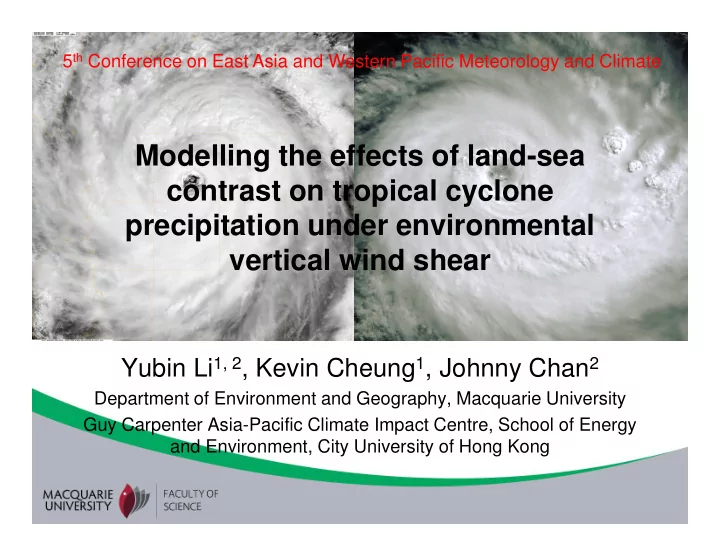

5 th Conference on East Asia and Western Pacific Meteorology and Climate Modelling the effects of land-sea contrast on tropical cyclone precipitation under environmental vertical wind shear Yubin Li 1, 2 , Kevin Cheung 1 , Johnny Chan 2 Department of Environment and Geography, Macquarie University Guy Carpenter Asia-Pacific Climate Impact Centre, School of Energy and Environment, City University of Hong Kong
Publications on TC Landfall Processes • Li, Y., K. K. W. Cheung, J. C. L. Chan, and M. Tokuno, 2013a: Rainfall distribution of five landfalling tropical cyclones in the northwestern Australian region. Aust. Meteor. Oceanog. J. , 63 , 325-338. • Li, Y., K. K. W. Cheung, and J. C. L. Chan, 2013b: Numerical study on the development of asymmetric convection and vertical wind shear during tropical cyclone landfall. Quart. J. Roy. Meteor. Soc. (in press). • Li, Y., K. K. W. Cheung, and J. C. L. Chan, 2013c: Modelling the effects of land-sea contrast on tropical cyclone precipitation under environmental vertical wind shear. Quart. J. Roy. Meteor. Soc. (submitted).
MOTIVATION strongest frictional convergence strongest frictional convergence TC George (2007) in Li et al. (2012) Typhoon Sam (1999) in Chan et al. (2004)
Proposed processes during TC landfall roughness and moisture differences friction asymmetric convection convergence/ divergence within B.L. asymmetric PV tendency diabatic heating distribution asymmetric asymmetric land-induced flow (lower-level) flow (upper-level) motion vertical wind shear
No environmental flow (and shear) Vertical wind speed profile for environmental VWS With environmental shear WRF idealized experiments
100 SW-10 LAND SEA y-displacement (km) RW-10 50 SD-10 RD-10 0 -50 -100 -250 -200 -150 -100 -50 0 50 100 150 200 250 x-displacement (km) Internally generated VWS is identified (no environmental VWS here) in the rough- land experiments. This VWS is nearly parallel to the coast during landfall.
Factors affecting TC rainfall during landfall • Change in vertical stability due to advection of dry air from land by the TC circulation • Land-sea contrast in surface friction • Internally generated VWS and environmental VWS • Have to consider cloud types with these factors!
Rainwater mixing ratio at σ σ =0.4 to 0.9 during σ σ landfall Inner-core convective rain develops from σ =0.4 Outer-band stratiform rain develops at much lower levels, and thus more affected by the land-sea contrast in surface friction
Rainwater mixing ratio at σ σ =1.0 and vertical σ σ stability at σ σ =0.88 σ σ SW and SD experiments shown here Note the difference in rain development on the offshore side, and increase in vertical stability Rainwater Vertical stability
Inner-core (<100 km) rain in RW and RD experiment Only internal VWS Azimuthal distribution, 0 ° is due east, 90 ° is due north, etc. More axisymmetric due to strong cyclonic advection and higher- level rain development 100 SW-10 LAND SEA y-displacement (km) RW-10 50 SD-10 RD-10 0 -50 -100 -250 -200 -150 -100 -50 0 50 100 150 200 250 x-displacement (km)
Outer-band rain in RW and RD experiment Rain concentrates on the Only internal VWS onshore side during landfall due to increased frictionally induced convergence Correlated with surface to PBL-top convergence pattern In RD, rain on the offshore side (270 ° ° ° ° degree) is also intense due to cyclonic advection and adjustment of radial wind (Li et al. 2013b)
How about when there is environmental VWS? (inner core) In the inner core, Easterly shear environmental VWS dominates. Rain concentrates Northerly shear on the downshear- Simulated landfall left side Southerly shear
How about when there is environmental VWS? (outer-band impacts) Although the Imposed easterly downshear to shear in the downshear-left environment (RD) relationship with Simulated landfall convection is still valid, note the transition from control by the internal VWS to the external (environmental) after landfall.
Proposed processes during TC landfall roughness and moisture differences Modification to vertical stability friction asymmetric convection convergence/ divergence within B.L. asymmetric PV tendency diabatic heating distribution asymmetric asymmetric land-induced flow (lower-level) flow (upper-level) motion vertical wind shear Environmental VWS
Recommend
More recommend